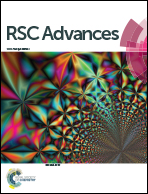Facile synthesis of polyaniline/carbon dot nanocomposites and their application as a fluorescent probe to detect mercury†
Abstract
In this work, for the first time, novel polyaniline/carbon dot (PANI/Cdot) nanocomposites have been synthesized using a simple method. Meanwhile, the bright fluorescence of Cdots is effectively quenched by PANI through fluorescence resonance energy transfer. With the addition of Hg2+, the strong binding affinity between Hg2+ and the amino groups of PANI makes the Cdots break away and release from the PANI, resulting in the restoration of Cdot fluorescence, which can be used as a fluorescent probe for Hg2+ detection. This fluorescence “off–on” signal is sensitive to the concentration of Hg2+, and there is a good linear relationship between the fluorescence intensity of Cdots and Hg2+ concentrations in the range of 0.05 to 1.0 μM. The detection limit for Hg2+ at a given concentration is 0.8 nM. Moreover, it turns out that the nanoprobes represent a rather high selectivity for Hg2+ detection. We believe that PANI/Cdot composites will emerge as a new class of fluorescence materials that could be very likely to be suitable for practical applications.


 Please wait while we load your content...
Please wait while we load your content...